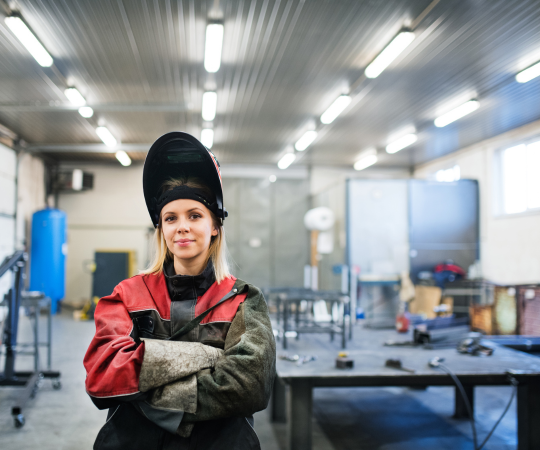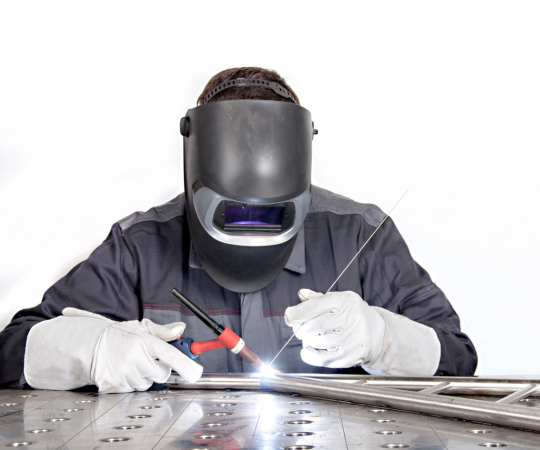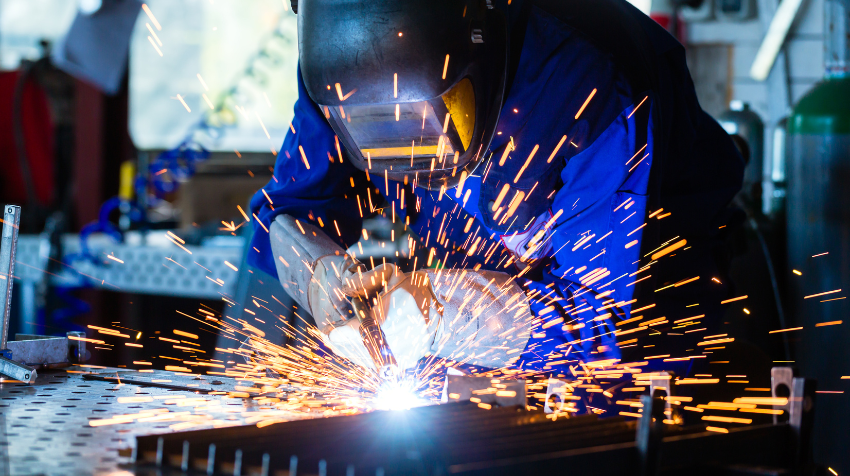From Novice to Expert: Mastering Welding Techniques Every Beginner Should Learn
So, you’re interested in welding? That’s great! Welding is an exciting and fulfilling skill to learn. It allows you to create things with your own two hands that can withstand the test of time. However, before you start burning metal, there are some essential techniques that you must know if you want to become a master welder.
First and foremost, safety should be your top priority when it comes to welding. Welding involves high temperatures and bright light that can damage your eyesight permanently. You also need to protect yourself from harmful fumes and gases that are released during the welding process.
In this article, we’ll cover all the necessary safety precautions you need to take before starting any welding project. Then, we’ll dive into the different welding techniques available to beginners like yourself. With practice and determination, these techniques will help you produce clean welds on various types of metals.
So buckle up and get ready for an exciting journey towards welding mastery!
Prioritize Safety Precautions
Safety first! Don’t skip this crucial step to welding success. When it comes to welding, safety gear importance can’t be overstated.
Welding involves high temperatures and bright light that can damage your eyesight permanently if you don’t wear the right protective gear. Before you begin welding, make sure you’ve got a helmet with a proper shade lens, gloves made of heat-resistant material, and long-sleeved shirts and pants that cover your skin completely.
Apart from wearing safety gear, adherence to safety protocol is equally important. Always ensure that your workplace is well-ventilated because welding produces fumes that can be harmful when inhaled. You should also keep fire extinguishers nearby as a precautionary measure against potential fires caused by sparks or hot metal pieces.
Remember, accidents can happen even to the most experienced welders; therefore, always prioritize safety measures before starting any project.
Now that you know how crucial it is to put on the right protective gear and follow proper safety protocols, let’s move on to learning different welding techniques.
Learn the Different Welding Techniques
Let’s dive into the diverse range of welding methods available and explore their unique features.
When it comes to welding, there are two main techniques: gas and arc. Gas welding uses a flame to heat up metal parts until they join together, while arc welding uses an electric current to create an arc that melts the metal.
Each method has its advantages and disadvantages, so it’s important to choose the right one for your project.
Gas welding is often used for smaller projects or when precision is required. It’s also a good choice if you’re working with thin metals, as it produces less heat than arc welding.
Arc welding, on the other hand, is better suited for heavy-duty jobs that require strong welds. It can also be used on thicker metals and in outdoor environments where wind might make gas welding difficult.
Mastering Welding Joints: A Deep Dive into Technique will help you understand the advantages and disadvantages of each technique without overwhelming you with technical jargon or confusing terminology.

Understand the Advantages and Disadvantages of Each Technique
As you explore the different welding techniques, you’ll gain a deeper understanding of which method is best suited for your project’s requirements and environment. Each technique has its own set of advantages and disadvantages that should be considered when deciding which one to use.
Here is a comparison analysis of the most commonly used welding techniques:
- MIG Welding: Pros – fast, efficient, good for thicker materials; Cons – requires shielding gas, not ideal for outdoor use
- TIG Welding: Pros – precise and clean welds, can weld almost any metal; Cons – slower process, requires more skill and experience
- Stick Welding: Pros – versatile, inexpensive equipment; Cons – messy process, difficult to control heat
By understanding the pros and cons of each technique, you’ll be able to choose the right one for your specific project needs. It’s important to also consider factors such as budget and available equipment when making your decision.
With this knowledge in mind, it’s time to practice welding on scrap metal to further develop your skills.
Practice Welding on Scrap Metal
You’ve learned the advantages and disadvantages of each welding technique, so it’s time to put your knowledge into practice.
To start, choose the right scrap metal for your project – one that’s similar in thickness and composition to what you’ll be welding in the future.
As you practice different techniques, pay attention to how they affect the weld quality and penetration.
Finally, evaluate your welds by looking for signs of cracking, porosity or other defects. This will allow you to make adjustments and continue improving your skills.
Remember that with practice and persistence, you can master this essential skill.
Choose the Right Metal
Picking the right metal is crucial for ensuring a successful weld, so make sure you take some time to consider your options. When it comes to welding materials selection, there are several factors that you need to keep in mind.
First and foremost, you need to consider the metal compatibility considerations. This means that you need to choose metals that can be welded together without causing any issues.
In addition to this, you also need to think about the thickness of the metal that you’ll be welding. Thicker metals require more heat and power, while thinner metals require less.
Furthermore, different types of metals have different properties and characteristics that affect their weldability. For instance, aluminum requires a different welding technique than steel or copper does. By choosing the right metal for your project and taking into account its specific properties, you can ensure that your welds will be strong and durable.
Now that you know how important it is to pick the right metal for welding success, it’s time to move on to practicing different techniques!
Practice Different Techniques
Let’s get started on honing our skills and exploring the art of welding by practicing diverse techniques. As a beginner, you should start with simple techniques such as tack welding or butt welding to build your confidence.
Once you feel comfortable with these techniques, move on to more complex ones like fillet welds or groove welds.
When practicing different welding techniques, it’s important to have the right equipment recommendations. A good quality welding helmet, gloves, and protective clothing are essential. Additionally, make sure that you have the appropriate electrode for the type of metal you’ll be working with.
Common mistakes can lead to poor welds and affect the overall strength of your workpiece. One common mistake is not cleaning the metal before beginning to weld; this can cause contamination in your weld, which weakens it over time. Another mistake is not controlling your heat input properly, which can cause warping or distortion in your workpiece.
As you practice different techniques and become more confident in your abilities, it’s important to evaluate your welds to ensure they meet industry standards. This will help you identify areas where improvement is needed and ultimately lead you towards mastery of the art of welding.
Evaluate Your Welds
It’s crucial to assess your welds regularly as they’re the foundation of your work and can determine the success or failure of your project. Evaluating your welds will help you identify any common mistakes that you make during the process.
Some of these mistakes include poor penetration, undercutting, lack of fusion, and porosity. To improve your welding skills, it’s essential to troubleshoot these issues and learn from them.
Quality control and inspection techniques such as dye penetrant testing or magnetic particle inspection can also help you detect flaws in your welds that may not be visible to the naked eye. By mastering these evaluation techniques, you’ll be able to create stronger bonds between metal pieces with fewer defects and achieve better results in all your welding projects.
And when you encounter challenges along the way, seek guidance from experts who have more experience than you do.
Seek Guidance from Experts
If you want to excel in welding, seeking guidance from experts is a must. Take a welding course to learn the basics and hone your skills.
Joining a welding community allows you to connect with other welders, share experiences, and get feedback. Learning from experienced welders gives you valuable insights into the craft and helps you avoid common mistakes.
By following these key points, you can accelerate your journey towards becoming a skilled welder.
Take a Welding Course
Enroll in a welding course to gain valuable hands-on experience and expert guidance that’ll help you perfect your craft. With the benefits of online learning, finding the right welding course has never been easier.
Look for courses that offer practical training and mentoring by experienced welders who can give you feedback on your technique and guide you through challenging projects. During the course, you’ll learn about different welding processes, safety procedures, and how to work with various materials.
You’ll have access to specialized equipment, tools, and materials that you may not be able to afford or find on your own. Plus, being part of a class or community with other aspiring welders can be motivating and inspiring. You can share tips, ask questions, and learn from each other’s mistakes.
Joining a welding community after completing a course is an excellent way to continue building your skills and network with like-minded individuals who share your passion for welding.
Join a Welding Community
Congratulations on taking a welding course! You’ve now laid the foundation for your journey towards welding mastery. But there’s still so much to learn, and you don’t have to do it alone.
Joining a welding community can greatly enhance your experience and expedite your progress. Finding mentors in a welding community can be invaluable. These experienced welders can guide you through difficult techniques and offer insight into the best practices of the trade. They may also provide feedback on your work, which will help you improve faster than if you were working solo.
Additionally, being part of a community allows for sharing experiences with others who are passionate about welding. This camaraderie creates a sense of belonging that is essential to staying motivated and engaged in learning.
As you continue to grow as a welder, it’s important to learn from experienced welders who have been in the field for many years. By doing so, you’ll gain insights into their processes and techniques that they’ve honed over time, which could help take your skills to the next level.
Let’s explore how this can be accomplished by attending workshops and seeking out opportunities to observe seasoned professionals at work.

Learn from Experienced Welders
Level up your welding skills by learning from seasoned professionals through workshops and witnessing their practiced processes. It’s essential to find experienced welders who can teach you the tricks of the trade and guide you on your journey to mastering welding techniques.
Here are some benefits of apprenticeships and finding welding mentors:
- Apprenticeships offer hands-on experience with an experienced welder, giving you real-world training that complements classroom learning.
- Welding mentors can provide valuable feedback on your work, helping you identify areas for improvement and offering tips for perfecting your technique.
- Learning from a mentor allows you to ask questions about specific projects or techniques, getting personalized advice that can help advance your skills more quickly than if you were only relying on books or online tutorials.
- A mentor can introduce you to new tools or technologies that could improve your performance or make certain tasks easier.
- Working alongside someone who has years of experience in the field gives you insight into what it takes to succeed as a welder, including what employers look for in candidates.
Finding a mentor might seem daunting at first, but it’s worth putting in the effort. Look for workshops or classes taught by experienced welders in your area, attend industry events and conferences where experts will be speaking, or reach out directly to reputable welding shops or companies to inquire about opportunities.
With hard work and dedication, learning from someone with more experience can help take your welding skills to the next level.
Frequently Asked Questions
What kind of safety gear do I need to wear while welding?
It’s incredibly important to prioritize safety when welding, as it can be a dangerous activity. There are several safety precautions you should take.
Start with proper eye protection. This includes wearing either a welding helmet or goggles with lenses that are specifically designed for welding.
Additionally, it’s crucial to wear protective clothing, such as long-sleeved shirts and pants made from flame-resistant material. You may also want to invest in leather gloves and boots that cover your ankles for added protection.
By taking these essential steps towards safety, you can help ensure that you’re well-protected while working on your welding projects.
How do I properly maintain and clean my welding equipment?
To properly maintain and clean your welding equipment, it’s important to follow a regular maintenance schedule. Begin by inspecting the equipment for any damage or wear and tear that may need to be repaired.
Then, use cleaning techniques such as wiping down with a damp cloth or using compressed air to remove any debris or dust buildup. It’s also important to regularly check and replace consumable parts such as nozzles, tips, and electrodes.
By following these steps, you can ensure that your welding equipment is always in top working condition and avoid any potential safety hazards. Remember to always prioritize safety when handling welding equipment and consult the manufacturer’s instructions for specific maintenance guidelines.
Can I weld on any type of metal or are there certain types that are not recommended?
Welding on unsuitable materials can result in a subpar weld that won’t hold up over time. It’s important to consider material compatibility before starting any welding project.
Not all metals are created equal, and some aren’t meant to be welded together. For example, aluminum and steel require different techniques due to their varying melting points and chemical compositions.
Additionally, certain coatings or finishes can release toxic fumes when heated during the welding process. As a knowledgeable welder, it’s crucial to research and understand the properties of the materials you plan to work with in order to ensure a successful outcome.
How do I know if my welds are strong enough for the intended purpose?
To ensure that your welds are strong enough for their intended purpose, you need to perform welding inspection and testing techniques. This is crucial since improperly welded joints can lead to safety hazards and structural failure.
Welding inspection involves examining the weld’s appearance, dimensions, and surface quality. You must also check for any cracks, porosity, or other defects that may compromise the strength of the joint.
Testing techniques include non-destructive testing (NDT) methods such as radiography, ultrasonic testing, magnetic particle inspection, dye penetrant inspection, and visual inspection. These methods help identify any hidden defects in the welded joint without damaging it.
By performing welding inspections and testing techniques regularly on your welds, you can ensure they meet industry standards and are strong enough for their intended use.
What are some common mistakes that beginners make when welding and how can I avoid them?
As a beginner welder, it’s crucial to avoid common mistakes that can compromise the strength and quality of your welds.
Improper preparation and incorrect welding technique are two of the most significant errors that beginners make.
To improve your weld quality, ensure proper joint fit up and appropriate electrode selection.
Think of welding like a dance; you want to move smoothly with precision while maintaining control.
With practice, patience, and attention to detail, you’ll soon be on your way to mastering this skill and feeling a sense of belonging in the welding community.
Conclusion
Congratulations! You’ve taken your first steps towards welding mastery. Remember, safety always comes first. Protect yourself with the right gear and equipment before you start welding. Make it a habit to check your tools and surroundings regularly.
Now that you know the basics of welding, it’s time to explore different techniques. Each technique has its own set of advantages and disadvantages, so take the time to understand them all. Don’t be afraid to experiment and find what works best for you.
As with any skill, practice makes perfect. Start small by practicing on scrap metal until you feel confident enough to tackle bigger projects. And don’t forget to seek guidance from experts along the way! Whether it’s a seasoned welder or an online community, there’s always someone who can offer valuable advice and support.
Welding may seem daunting at first, but with patience and perseverance, you’ll soon discover the joy of creating something new from raw materials. So go ahead—spark up that torch and let your creativity shine!
Related Source

